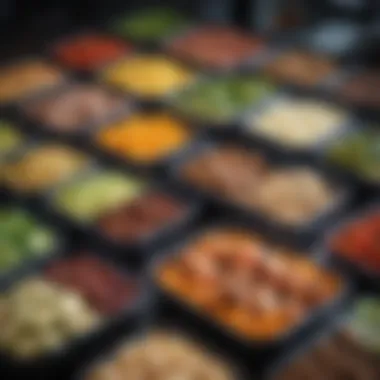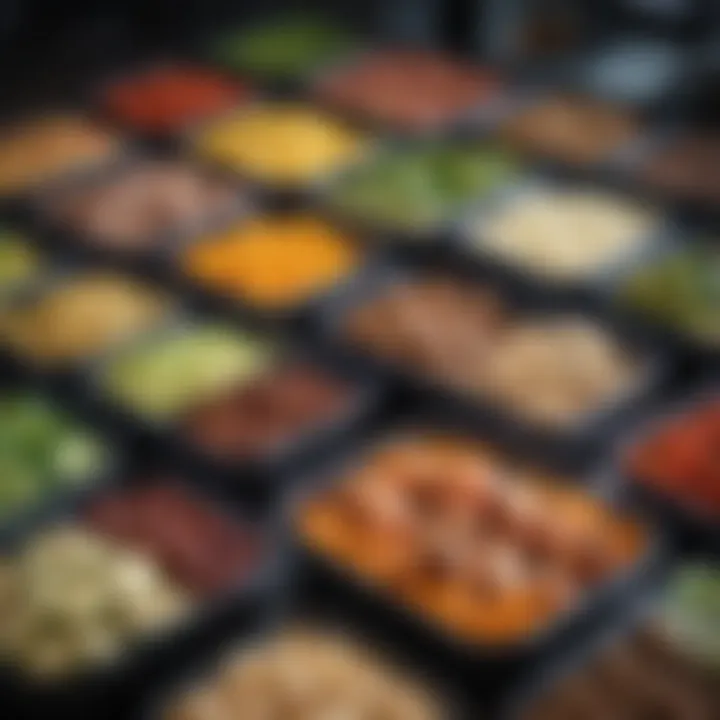Healthy Lunch Ideas for Weight Loss Success


Intro
Eating a healthy lunch is crucial for those pursuing weight loss. Lunch is often the most neglected meal, yet it plays a pivotal role in maintaining energy levels and supporting overall health. This article guides readers through simple strategies that aid in meal planning, ingredient selection, and recipe creation aimed at enhanced weight loss efforts.
Understanding how to create balanced and satisfying meals is key. When people think of weight loss, the focus is often on restrictive diets or calorie counting. However, a more effective approach is to concentrate on nutrient-rich, wholesome foods that provide satisfaction and curb unhealthy cravings. With a commitment to improving dietary habits, one can make substantial progress toward their weight loss goals.
Key Benefits
Physical Health Benefits
- Nutrient Density: Incorporating vegetables, lean proteins, and whole grains ensures meals are packed with essential nutrients. Nutrient-rich foods support metabolism, lower inflammation, and promote muscle health.
- Weight Management: Consuming balanced lunches helps regulate appetite, reducing the likelihood of overeating later in the day. Foods high in fiber, such as fruits and vegetables, contribute to this balance.
- Energy Boost: Eating a wholesome lunch provides the energy needed to remain productive throughout the afternoon, thereby supporting ongoing weight loss efforts.
Mental Well-being Enhancements
- Cognitive Function: Foods rich in omega-3 fatty acids, antioxidants, and vitamins can enhance brain health, improving focus and concentration during work or daily activities.
- Mood Stabilization: Healthy lunches contribute to better mood regulation. By preventing blood sugar spikes and crashes, a balanced meal can lead to more consistent energy and emotional stability.
"The focus on eating nutrient-dense meals can lead to improved physical and mental health outcomes."
Practical Tips
Effective Meal Planning
- Plan Ahead: Allocate time each week to plan meals, making choices easier. Consider preparing components in advance, such as chopping vegetables or cooking grains.
- Smart Shopping: Create a grocery list based on your planned meals to avoid impulse buys. Stick to the outer aisles of the supermarket to find healthy options like fresh produce and lean proteins.
- Batch Cooking: Preparing larger quantities of healthy meals can save time and ensure that options are always available during busy days.
Quick and Efficient Workouts
While this section is primarily about lunch, staying active enhances overall weight loss efforts. Here are a few quick workouts to incorporate:
- Walking: A simple 10-20 minute walk can enliven the body and mind, helping to manage weight effectively.
- Bodyweight Exercises: Incorporate push-ups, squats, or lunges into your day. Even a short session can boost metabolism.
Importance of Lunch in Weight Loss
Lunch plays a pivotal role in the weight loss journey. This meal acts as a crucial checkpoint in daily eating habits, capable of influencing both metabolism and overall caloric intake. Many people often overlook lunch or opt for unhealthy choices due to time constraints. However, understanding its importance can help in making better dietary decisions.
Role of Lunch in Metabolism
Lunch significantly affects metabolism. After breakfast, the body's metabolism continues to process food, but it can slow down if there is a prolonged period without intake. Eating lunch energizes the body, helping to maintain metabolic rates throughout the afternoon. It also prevents noon energy slumps by providing necessary nutrients. When a balanced lunch is consumed, the body is more likely to burn calories efficiently. As a result, a well-planned lunch can act as a metabolic booster instead of hindering weight loss efforts.
Impact on Caloric Intake
The choices made at lunch can determine overall caloric intake for the day. Studies show that individuals who skip lunch or consume low-quality meals tend to overeat during later meals or snack on unhealthy items. Regularly consuming a nutritious lunch helps control hunger levels, reducing the likelihood of excessive calorie consumption. Moreover, it supports balanced blood sugar levels, which plays a vital role in hunger regulation. Opting for a mix of proteins, healthy fats, and carbohydrates can create a satisfying meal that precludes cravings.
A nutritious lunch can set the tone for the rest of the day, supporting effective weight management and overall health.
Nutritional Components of a Weight Loss Lunch
Understanding the nutritional components that make up a weight loss lunch is vital for those aiming to shed pounds while still enjoying their meals. The right balance of macronutrients and micronutrients not only supports weight loss, but also sustains energy levels and enhances overall health. A lunch rich in essential nutrients can help maintain metabolism, regulate appetite, and provide the necessary vitamins and minerals required for optimal bodily function.
Essential Macronutrients
Macronutrients play a crucial role in designing a weight loss lunch. The three primary types – proteins, carbohydrates, and fats – each contribute to satiety and energy levels in distinct ways.
Proteins
Proteins are essential for muscle repair and growth. In the context of weight loss, they play a significant role in reducing appetite. Eating a protein-rich lunch can lead to increased feelings of fullness compared to meals low in protein. Chicken breasts, tofu, and lentils are excellent options. One unique feature of proteins is their thermic effect; the body burns more calories digesting proteins than it does for fats or carbohydrates. While they are generally beneficial, it's important to choose lean sources to avoid excessive fat intake.
Carbohydrates
Carbohydrates are often misunderstood in terms of weight loss. They serve as the primary energy source for our bodies. Incorporating complex carbohydrates, such as whole grains and vegetables, ensures a steady release of energy. A key characteristic is their fiber content, which aids in digestion and promotes a sense of fullness. However, it is important to limit refined carbohydrates, which can lead to weight gain due to their high glycemic index.
Fats
Fats are crucial for hormone production and nutrient absorption. Healthy fats, such as those found in avocados, nuts, and olive oil, can enhance the flavor of a meal and contribute to satiety. Their key characteristic includes providing essential fatty acids that the body cannot produce. Moderate consumption of healthy fats is beneficial but should be balanced to prevent excess calories.
Micro Nutrients That Aid Weight Loss
Micronutrients, though required in smaller amounts, are essential for various body functions. Vitamins and minerals contribute to energy production and metabolic processes, which are fundamental for weight loss.


Vitamins
Vitamins, such as those from the B-complex group, are vital for energy metabolism. They help convert food into energy and promote overall bodily functions. A defining feature is that different vitamins serve specific roles; for example, Vitamin D supports bone health, while Vitamin C assists in immune function. Including a variety of fruits and vegetables helps to ensure adequate vitamin intake for weight loss.
Minerals
Minerals such as magnesium and potassium support muscle function and fluid balance in the body. These nutrients are important during weight loss, particularly for those engaging in physical activity. A notable characteristic is that many minerals function synergistically; for example, calcium and magnesium work together for muscle contraction and relaxation. It's worth noting that mineral deficiencies can hinder weight loss efforts.
Antioxidants
Antioxidants play a protective role against oxidative stress in the body. They can be found in various fruits and vegetables. Blueberries and spinach are good examples of antioxidant-rich foods. Their key characteristic is their ability to reduce inflammation, which can be beneficial for maintaining a healthy weight. One unique feature is their contribution to overall health, supporting not just physical, but also mental well-being.
A well-balanced lunch consisting of the right nutritional components aids in creating sustainable weight loss while providing energy and essential nutrients for a healthy lifestyle.
Planning Your Weight Loss Lunch
A well-structured plan for your lunch holds vital importance in your journey toward weight loss. Planning helps you make informed choices about what you eat and when you eat. When you plan your weight loss lunch, you can ensure that it aligns with your dietary goals while still offering satisfaction and nourishment.
With a conscious approach to meal planning, you minimize the risk of reaching for unhealthy options, especially when time is limited or cravings hit. Effective planning incorporates components that contribute to satiety and nutrition.
The benefits of dedicated lunch planning are significant. First, it helps with portion control. You can measure ingredients in advance, preventing overeating. Second, planning fosters creativity in the kitchen. By experimenting with different recipes and ingredients, you can build a diverse menu that keeps your lunch experience enjoyable. Lastly, it saves time. Preparing in advance frees you from daily decision fatigue, allowing you to utilize your lunch break more productively.
Setting Dietary Goals
Establishing clear dietary goals is a pivotal step in your weight loss journey. Goal setting helps you identify what you aim to achieve with your lunch choices. Are you looking to cut calories? Focus on higher protein intake? Or perhaps boost your vegetable consumption? These goals shape your approach to meal planning.
When setting goals, it's important to be specific. Instead of vague intentions like "eat healthier," you could aim for something like "include one serving of greens in my lunch every day." Specific targets make it easier to track progress.
Furthermore, consider your personal preferences and lifestyle. Align your dietary goals with what you actively enjoy eating and what fits your schedule. This personal touch will enhance the sustainability of your goals.
Meal Prep Strategies
Optimizing your lunch through meal prep strategies is a practical approach. Preparing meals in advance ensures you always have healthy options available. Here are some straightforward strategies to consider:
- Batch Cooking: Prepare larger quantities of foods like quinoa, roasted vegetables, or grilled chicken. Portion them into containers to use throughout the week.
- Ingredient Preparation: Chop vegetables and store them in the fridge for easy access. This reduces prep time, making it more likely that you’ll stick to your healthy choices.
- Plan for Variety: Rotate ingredients to avoid monotony. Incorporate different proteins, grains, and vegetables each week to keep meals interesting.
- Use Time Efficiently: Consider using your weekends to prepare meals. Perhaps designating a couple of hours to meal prep can relieve stress during busier weekdays.
Successful meal prep leads to better adherence to your weight loss lunch strategies. You eliminate uncertainty and make healthy eating more convenient.
Quick and Healthy Lunch Ideas
Quick and healthy lunch ideas play a critical role in supporting weight loss objectives. They provide the essential nutrients while preventing excessive calorie intake throughout the day. These ideas are designed to be simple and adaptable, making it easier for individuals to maintain a balanced diet without complex preparations. Convenience matters a lot in the fast-paced world, where often, lunch is skipped or replaced with unhealthy options due to time constraints. Therefore, having a set of healthy lunch ideas allows for thoughtful choices that contribute positively towards weight management.
Salad Variations
Greens and Vegetables
Greens and vegetables form the backbone of a healthy salad. They are low in calories but high in fiber, making them an ideal choice for weight loss. The key characteristic of greens is their high nutrient density, meaning they provide a lot of vitamins and minerals for a relatively low calorie count. Incorporating a variety of leafy greens like spinach, kale, and arugula not only boosts the nutritional value but also enhances the flavor profile.
Another unique feature of these ingredients is their role in promoting satiety. Since they require more chewing and digesting, they can help keep hunger at bay longer. Yet, some individuals may find it difficult to have greens solely as a meal, which may limit their overall appeal.
Protein Additions
Protein additions enhance the overall nutritional value of a salad by providing essential amino acids. They play a crucial role in muscle repair and growth, which is beneficial for those who are active and trying to lose weight. Options like grilled chicken, chickpeas, or quinoa offer a substantial protein boost without a lot of calories.
The key characteristic of protein-rich foods is their satiating nature. They help to promote feelings of fullness and can prevent overeating later in the day. A unique feature of incorporating protein is the versatility it adds to a meal. However, individuals could face challenges selecting lean protein sources, as some can be high in saturated fats, which may counteract weight loss efforts.
Dressings
Dressings can either make or break a healthy salad. The right dressings can boost flavor without adding excessive calories. Homemade vinaigrettes or yogurt-based dressings are beneficial choices because they can be tailored to taste, balancing flavors without compromising on health.
A key characteristic of dressings is their ability to enhance the enjoyment of a meal, making healthier options more appealing. Unique to this section is the emphasis on portion control; dressings can introduce hidden sugars and fats when used excessively. Thus, moderation is crucial for maintaining the benefits while minimizing negative impacts.
Wraps and Sandwiches
Wraps and sandwiches provide a myriad of possibilities for healthy eating. The variety of bread types and fill-ins allows for numerous combinations. Opting for whole-grain options ensures a higher fiber content, which can aid digestion and promote satiety. Adding proteins, vegetables, and healthy fats in wraps makes them not only convenient but also nutrient-dense, supporting weight loss goals.
Rice and Grain Bowls
Rice and grain bowls offer a substantial and filling meal option. Base layers of quinoa, brown rice, or farro can be complemented with protein sources and an array of vegetables. This combination allows for balanced nutrition in one meal. These bowls can also be meal prepped in advance, allowing for both convenience and healthy eating. Variety in toppings and sauces can help keep meals interesting while still focusing on weight loss.


Incorporating Superfoods into Lunch
Incorporating superfoods into lunch is an essential strategy for those focused on weight loss. These foods not only provide high nutritional value but also enhance the overall quality of meals. Superfoods are rich in vitamins, minerals, antioxidants, and fiber, which can contribute significantly to a healthier lifestyle. Using superfoods can boost energy levels and improve digestion, making them a valuable addition to any lunch.
Benefits of Superfoods
Superfoods offer a variety of benefits that can support weight loss efforts. First, their nutrient density means that even in small servings, they provide substantial health benefits. They can promote a feeling of fullness, which may prevent overeating later in the day. Furthermore, many superfoods contain compounds that aid in fat metabolism and reduce inflammation, contributing to overall well-being. Incorporating these foods into lunch can create a satisfying meal that supports dietary goals without sacrificing flavor.
Popular Superfoods for Weight Loss
Quinoa
Quinoa is a highly regarded superfood that serves as a great source of complex carbohydrates and protein. It is gluten-free and contains all nine essential amino acids, making it a complete protein. Its high fiber content supports digestion and helps maintain a feeling of fullness. Quinoa is also low on the glycemic index, which means it can help manage blood sugar levels.
The unique feature of quinoa is its versatility; it can be easily added to salads, bowls, or used as a base for various dishes. However, some might find it slightly more expensive compared to traditional grains, which could be a disadvantage depending on budget.
Chia Seeds
Chia seeds are another excellent superfood ideal for weight loss. They are exceptionally rich in omega-3 fatty acids, which are crucial for heart health. Chia seeds also absorb liquid, expanding in size and forming a gel. This quality can help satisfy hunger and prevent cravings.
Chia seeds are easy to incorporate into lunches by adding them to smoothies, yogurt, or salads. One disadvantage to note is their caloric density; while healthy, they can contribute to higher calorie counts if used excessively. Moderation is key.
Leafy Greens
Leafy greens, such as spinach and kale, are another vital component of a weight loss-focused lunch. They are low in calories but high in nutrients, including vitamins A, C, and K, and minerals such as iron and calcium. The high water content in leafy greens also contributes to hydration and satiety, making them an excellent base for salads or added to wraps.
The key characteristic of leafy greens is that they can be consumed in large quantities without significant calorie intake, which is beneficial in a weight-loss diet. A potential disadvantage is that their taste might not appeal to everyone, though adding dressing or mixing with other ingredients can help enhance flavor.
Hydration and Its Role in Weight Loss
Proper hydration is essential when it comes to weight loss. It plays a multifaceted role that is often overlooked. Water is not just crucial for survival; it can also assist in the regulation of appetite, energy levels, and overall metabolic function. Maintaining optimal hydration can make a significant difference in how one feels and performs throughout the day. Staying hydrated can enhance workout efficiency and support recovery, thus contributing to better weight management.
Importance of Water Intake
Water intake should not be underestimated. When the body becomes dehydrated, it can often misinterpret signals of thirst as hunger. This may lead to unnecessary snacking or overeating. Consuming adequate amounts of water can help in controlling caloric intake by ensuring that thirst does not confuse with hunger. Furthermore, hydration supports cellular functions that are necessary for energy production and recovery. Each organ requires water to function effectively; thus, prioritizing water can result in improved overall health.
"Water intake should not merely be fulfilling a quota but realized as a tool in balancing appetite and enhancing metabolism."
Infused Waters and Herbal Teas
For those who find plain water unappealing, infused waters and herbal teas can be excellent alternatives. Infused waters can add unique flavors and nutrients without excessive calories. Common ingredients like lemon, cucumber, or mint can enhance the taste and provide additional health benefits. Similarly, herbal teas such as green tea offer antioxidants and may even enhance fat oxidation, aiding in weight loss.
Incorporating these beverages into one's daily routine may also encourage more frequent fluid intake. Not only does this improve hydration, but it also satisfies taste preferences. Having a variety of drinks can help reach hydration goals while providing enjoyment.
Including infused waters and herbal teas in lunch can enhance not only hydration but also the overall health profile of the meal.
Overcoming Common Lunch Challenges
In the journey toward weight loss, lunch can often be a challenging meal. This section highlights the most pressing difficulties individuals face when trying to stay healthy during lunchtime. Recognizing and addressing these challenges is essential for maintaining a balanced diet and achieving weight loss goals. By implementing effective strategies, one can ensure the lunch hour becomes a time for nourishment rather than a source of frustration.
Managing Time Constraints
Many individuals find that their days are packed with responsibilities, leaving little time to prepare a healthy lunch. Managing time constraints is crucial, as skipping meals or resorting to fast food can derail efforts to eat healthily. Meal prep is an effective solution to this common problem. Preparing meals in advance saves time during busy weekdays.
You can dedicate a few hours one day a week to cook and portion meals for the week ahead. Consider easy-to-make options such as roasted vegetables, grilled chicken, or quinoa salads that can be refrigerated and used throughout the week. Having a prepared meal ready eliminates the temptation to opt for unhealthy convenience foods.
Another strategy is to consider quick and nutritious recipes. Emphasizing recipes that require minimal ingredients reduces preparation time. For instance, a simple wrap with whole grain tortillas, lean protein, and plenty of veggies can be assembled in mere minutes.
Dealing with Cravings
Cravings can undermine even the best intentions for a healthy lunch. Factors such as stress, fatigue, or simply hunger can lead to rushing towards high-calorie snacks or meals. Effectively handling cravings is therefore essential for long-term weight management.
One effective method to combat cravings is to incorporate high-fiber and high-protein foods into lunches. Foods rich in fiber like beans, whole grains, and vegetables help maintain satiety and manage hunger levels. Additionally, including protein sources such as chicken, fish, or legumes can prevent the sudden urge for unhealthy options.
Another strategy is mindfulness. Practicing mindfulness while eating can help one stay connected to hunger cues and make more conscious choices. Taking time to savor each bite and focusing on the eating experience can aid in recognizing when one is satisfied, preventing overeating.
"Understanding common lunch challenges is the first step to overcoming them."
Balancing Taste and Health


Finding a balance between taste and health is critical when planning a lunch that supports weight loss. Many people perceive healthy eating as synonymous with blandness, leading to an inevitable decline in adherence to nutritious meal plans. For sustainable weight loss, meals must not only provide the necessary nutrients but also satisfy the palate.
To achieve this balance, focus on incorporating diverse flavors and textures. Using various spices and herbs can dramatically enhance the taste of dishes without adding significant calories or unhealthy ingredients. Moreover, paying attention to cooking techniques can preserve the natural flavors and nutrients of food.
It is essential to understand that healthy eating should not be a compromise. By prioritizing flavor, individuals are more likely to enjoy their meals, which encourages consistent healthy choices over time. When meals are both nutritious and delicious, they become part of a long-term lifestyle rather than a short-term diet. This approach also supports the psychological aspect of eating, where enjoyment plays a significant role in meal satisfaction.
"Taste and health should be allies, not adversaries. The right flavors can elevate healthy eating into an enjoyable experience, leading to lasting dietary changes."
Flavorful Seasoning Options
Seasonings are a fundamental aspect of culinary arts that can transform a simple dish into an extraordinary one. Healthy lunches can be made flavorful through the wise use of herbs, spices, and condiments.
Options like garlic, ginger, turmeric, and cumin can add depth without raising caloric content. Fresh herbs like basil, cilantro, and parsley not only enhance flavor but also provide additional nutritional benefits. For those seeking tanginess, lemon juice or vinegar can liven up salads and grain bowls quickly.
In addition to traditional seasonings, consider trying exotic options such as za'atar or harissa, which can introduce unique flavors into meals. Experimenting with seasoning combinations can enhance many dishes, from roasted vegetables to grain salads.
Healthy Cooking Techniques
The method of preparation often influences both the taste and healthiness of meals. Employing cooking techniques that retain nutrients and enhance flavor can significantly impact the overall quality of a lunch.
- Steaming: This method maintains the integrity of vegetables, preserving their color, flavor, and nutrient content. It is an excellent technique for cooking asparagous, broccoli, or sweet potatoes.
- Grilling: Grilling adds a smoky flavor, particularly to proteins like chicken or fish. This method requires less unhealthy fat than frying.
- Sautéing: Using a small amount of healthy oils for sautéing can impart a rich taste while remaining health-conscious. Olive oil or avocado oil are optimal choices due to their health benefits.
- Baking: For those looking to create a satisfying lunch, baking ingredients such as chickpeas or sweet potatoes can create hearty, pleasing textures without excessive oil.
Incorporating these cooking techniques offers versatility and innovation in healthy eating while ensuring that meals remain appealing and enjoyable. The aim should always be to cultivate a dining experience that one looks forward to, which will facilitate a positive relationship with food.
Feedback Analysis for Lunch Choices
Understanding the significance of feedback analysis for lunch choices plays a pivotal role in maintaining a healthy eating pattern for weight loss. This process allows individuals to reflect on their meal experiences, gauge their satisfaction, and make informed decisions moving forward. By systematically evaluating what works and what does not, one can ensure that future lunch options align more closely with personal preferences and nutritional requirements.
Evaluating Meal Satisfaction
Evaluating meal satisfaction involves a careful examination of how a particular lunch affects both physical and emotional well-being. It is essential to consider various dimensions:
- Nutritional Value: Assess whether the meal provided adequate nutrients, aligning with dietary goals for weight loss.
- Taste and Texture: Reflect on whether the flavors and textures met expectations. Positive experiences can enhance adherence to a healthy eating pattern.
- Satiety Levels: Understand how filling the meal felt. Did it satisfy hunger adequately without leading to additional cravings?
Keeping a food diary may help track this feedback. Include descriptions of portion size, feelings before and after the meal, and any cravings experienced later. Over time, patterns may emerge that reveal preferences or areas needing adjustment.
Adjusting Based on Results
Once feedback has been evaluated, it becomes crucial to adjust future meals accordingly. This may involve:
- Substituting Ingredients: If something didn't sit well or lacked flavor, consider swapping out ingredients for healthier or more flavorful options.
- Modifying Portion Sizes: If meals did not provide the desired satiety, it might be necessary to adjust portion sizes or include more filling foods, such as fiber-rich vegetables or proteins.
- Experimenting with Cooking Methods: Techniques like grilling, steaming, or roasting can significantly affect meal satisfaction. If a dish did not appeal, altering how it is prepared could make a difference.
Applying these adjustments consistently can support effective eating habits. Tracking changes over time helps in refining choices to enhance overall satisfaction and success in weight management.
Feedback analysis is not merely a reactive process; it is an ongoing strategy aimed at optimizing daily choices and reinforcing long-term habits.
Sustaining Long-term Healthy Lunch Habits
Sustaining long-term healthy lunch habits is crucial for anyone aiming to lose weight and maintain overall well-being. Lunch acts as a central meal during the day, influencing energy levels and food choices for subsequent meals. If a person develops a habit of consuming balanced lunches rich in nutrients, they are less likely to turn to unhealthy snacks or meals later. This continuity in healthy eating can lead to significant weight loss over time.
Creating sustainable habits revolves around understanding personal preferences and nutritional needs. Each person's body responds differently to various foods, which means individual experimentation can lead to better results. By integrating healthy lunch options into daily routines, you not only promote weight loss but also encourage positive lifestyle changes that can make a lasting impact on overall health.
Long-term success hinges on consistency, which is fostered by strategies that simplify meal planning, increase satisfaction, and reduce stress surrounding food choices. For instance, individuals can keep a log of their meals to identify what works best for them, allowing for adjustments based on dietary goals and feedback.
Creating a Flexible Meal Plan
A flexible meal plan is vital for maintaining healthy lunch habits. It allows individuals to adapt their meals to changing schedules and preferences while still adhering to their dietary goals. Flexibility reduces feelings of deprivation, often a barrier to sustaining healthy eating habits. Here are some key aspects to consider when creating a flexible meal plan:
- Adaptability: Ensure that your plan can accommodate unexpected changes, like a busy day. Have quick options ready, such as pre-prepped salads or grain bowls.
- Portion Control: Consider varying portion sizes depending on your daily activity level. On more active days, extra carbohydrates may be needed, whereas lighter days can adjust towards protein-rich meals.
- Ingredient Substitution: Keep a list of interchangeable ingredients that fit your health goals. For example, if you usually use quinoa, occasionally swapping it with farro or brown rice can add variety without compromising nutrition.
A flexible meal plan keeps lunch enjoyable and allows for exploration of new foods while still meeting weight loss and health objectives.
Incorporating Variety
Incorporating variety into lunch is essential for preventing boredom and promoting adherence to healthy eating routines. A lunch that feels monotonous can lead to cravings for unhealthy alternatives. To avoid this, consider the following strategies for variety:
- Explore Global Cuisines: Try incorporating elements from different cuisines. Mediterranean, Asian, or Mexican flares can inspire new dishes that maintain nutritional integrity while tantalizing the palate.
- Use Seasonal Ingredients: Focus on using seasonal fruits and vegetables. These foods are usually more flavorful and nutrient-dense, enhancing your meals.
- Experiment with Flavors: Introduce different herbs and spices to your meals. Flavor-disruptive elements can transform simple ingredients into something innovative and exciting.
By diversifying your lunches, you not only optimize your nutrient intake but also find joy in the process of healthy eating. This commitment to variety supports sustainable habits that align with long-term health and weight goals.
Embracing variety in your diet proves to be an effective approach to maintaining interest and satisfaction in meals, thereby fostering healthier eating habits.
Ultimately, by creating a flexible meal plan and incorporating variety, you lay down a solid foundation for sustaining long-term healthy lunch habits, essential for addressing weight loss objectives.
For more insights on meal planning and nutrition, you can visit Wikipedia or Britannica.















